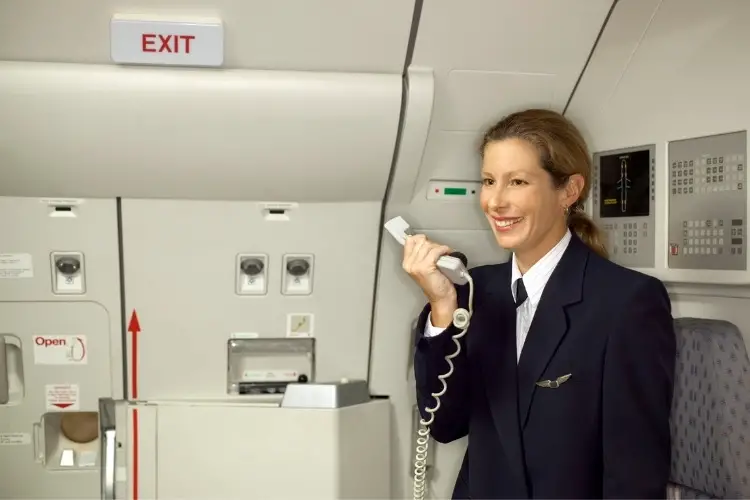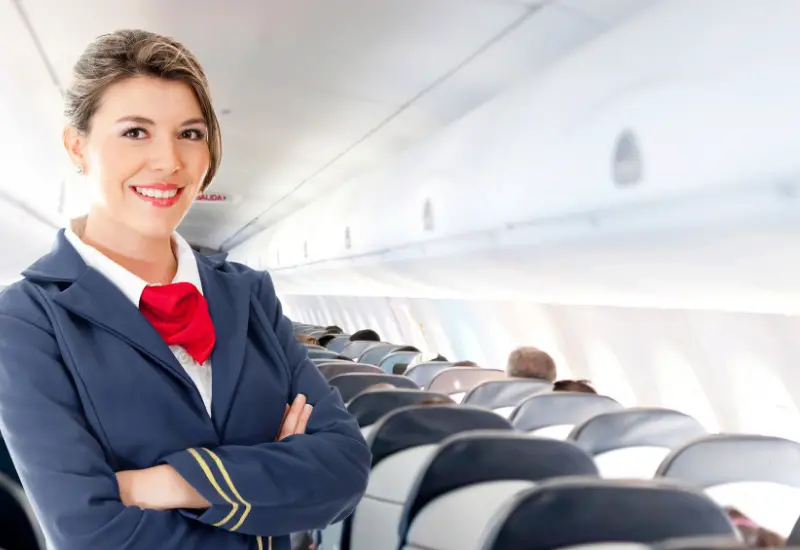Have you ever heard someone introduce themselves on the intercom as your “purser for this flight,” and wondered what that meant?
Or maybe you have been browsing for jobs as a flight attendant and seen mentions of pursers but don’t really understand why they are considered different from other crewmembers.
If you have any questions about who pursers are, what they do, and why they are special, then you have clicked on the right blog post, because we are going to explain all of it here!
What is a Purser?
A purser is the lead flight attendant on a given flight, kind of like a manager. They have additional training qualifications to help them ensure flight safety, service standards, and crew harmony.
Pursers are usually pretty senior, in terms of company seniority, and it often takes years to be accepted into purser programs with commercial airlines.
They usually have additional responsibilities to attend to before, during, and after the flight.
Therefore they also tend to earn a higher wage than a flight attendant in a regular position.
💡 Note: Most US-based airlines only have pursers on international flights. On domestic flights, there will be a “lead” flight attendant who takes on some of the same responsibilities as a purser, but they don’t need additional training to work this position, even though they often perform many of the same responsibilities.
The Role of a Purser
Pursers and leads act as a kind of liaison between other airline work groups (management, pilots, mechanics, caterers, gate agents, etc.) and their crew.
They are also responsible for ensuring their crews are able to provide the best possible experience to the passengers.
As you can imagine quite a lot of work is required to pull this off, so let’s explore what a purser does.
Consider this, a day in the life of a purser.
Prior to departure
Before the flight even starts to board, pursers have a few things they need to accomplish.
If they are working an international flight, they will first need to stop by the crew operations center to pick up the required paperwork, forms, and international briefing packets.
Once at the gate they will usually complete a brief with the gate staff to develop a plan so the agents and the flight crew can work together efficiently to get the flight out on time.
Then, once they have boarded the aircraft they will meet with the pilots and receive a briefing from the captain, during which they will make sure to discuss all of the following topics:
- Weather and expected turbulence
- Flight safety and security
- Flight time
At this point, they will also likely coordinate a system for when the pilots will take their respective breaks.
Once the purser has received this information, they will relay that information during the crew briefing they lead with the rest of the flight attendants.
During this briefing the purser must cover the following points:
- Everything from the pilot’s briefing
- The expected service standards for the flight
- Special passengers (VIPS, passengers needing extra assistance, etc.)
- Confirmation that everyone on the crew has their required equipment and have current certifications
- Layover safety (emergency meeting point, airline contacts at location, etc.)
They will then check to make sure that the crew has everything they need for the flight, including proper catering, amenity kits, and emergency equipment. And ensure that all the inflight entertainment systems are working properly.
To be fair, other flight attendants are also responsible for helping with these tasks.
For example, the galley flight attendant should be the one to count the meals, the Purser is simply supposed to confirm with them that everything is right and ready to go.
Inflight

During the flight, pursers have a dual role.
On the one hand, they have will work alongside other flight attendants to complete the cabin service, usually in the premium cabins.
On the other hand, they are also responsible for communicating with the pilots, coordinating crew rest rotations, and dealing with high-level incidents that might take place inflight including:
- Medical emergencies
- Passenger complains
- Inflight entertainment issues
They are also often required to personally seek out and thank any VIPs onboard.
International Flights
On international flights pursers also have to facilitate the right customs and immigration procedures.
A process that includes the following tasks:
- Distribution of customs and immigrations forms to passengers
- Collection of any necessary forms from crew members
- Inventory of all items the airline has to declare to customs (including alcohol, duty-free items, and high-value electronics).
Pursers also usually have to ensure that carts containing declared items belonging to the airline are locked with special seals before the aircraft lands.
This includes carts containing alcohol, duty-free items, and even the headsets they lend to premium passengers.
After Flight
Depending on where they land pursers have a few things that they are responsible for after they have left the airplane.
At Destination
When the crew is on their layover the purser is responsible for ensuring the layover runs smoothly.
To do this they have to:
- Make sure everyone makes it onto the bus to the hotel
- Help sign all of the crew into the hotel and distribute key cards
- Contact the company in the event of a crew emergency
They will often receive support from the designated language interpreter for these tasks as well.
At Home
Unlike the other flight attendants who can simply go straight home, pursers must finish a few tasks at the end of their trips.
They usually have to accomplish the following things within 24-hours of returning to their base airport:
- Write and submit incident reports
- Write and submit flight attendant performance assessments
- Digitally submit the flight’s final sales receipts
- Return any filled-out paperwork to the crew operations center
How Much Do Pursers Earn?
Being a purser is a lot of extra work, compared to the standard flight attendant’s responsibilities. Therefore, pursers actually earn a little more than an average flight attendant.
How much pursers make depends on the airline they work for and how many purser flights they fly. That said, pursers usually make an extra $10-15 an hour on the flights they work as pursers.
On average, pursers make between $40,000 and $55,000 a year in the United States and can go up to $80,000 for more senior pursers. This salary includes payment for their flight hours, layover payments (per diem) and any other bonuses.
Suggested reading: How Much Do Flight Attendants Really Make?
💡 Side note: just because a flight attendant is purser qualified, does not mean they will always fly that position. If a more senior purser wants the trip, they will get the position and the pay.
Lead flight attendants on domestic flights also get a small pay-bump for working that position, even though they aren’t technically pursers. They usually will make an extra $3-6 an hour depending on the size of the aircraft.
Conclusion
Purser flight attendants serve an important role and are often required to deal with difficult situations. So, the next time you are on a flight, keep an eye out for the purser and give them some appreciation!




